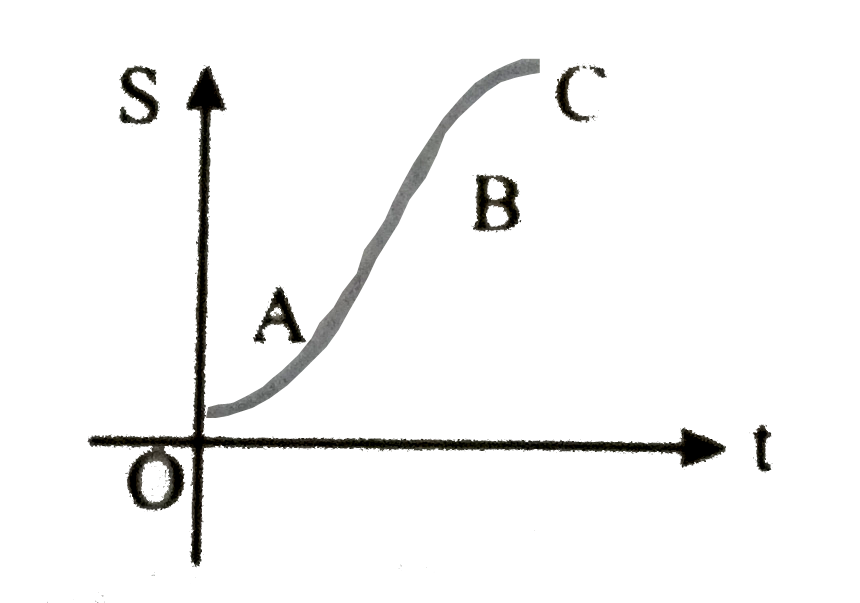A particle moving in a straight line has velocity-displacement equation as v=5√1+s. Here v is in ms−1 and s in metres. Select the correct alternative.
Particle is initially at rest
Initially velocity of the particle is 5m/s and the particle has a constant acceleration of 12.5ms−2
Particle moves with a uniform velocity
None of the above
The correct Answer is:B
To solve the problem, we start with the given velocity-displacement equation:
v=5√1+s
Step 1: Square both sides
To eliminate the square root, we square both sides of the equation:
v2=(5√1+s)2
This simplifies to:
v2=25(1+s)
Step 2: Expand the equation
Expanding the right-hand side gives us:
v2=25+25s
Step 3: Compare with the standard equation
We know from kinematics that the equation relating velocity, initial velocity, acceleration, and displacement is:
v2=u2+2as
Where:
- v is the final velocity,
- u is the initial velocity,
- a is the acceleration,
- s is the displacement.
Step 4: Identify terms
By comparing the two equations:
1. From v2=25+25s, we can see that:
- u2=25 (which implies u=5 or u=−5)
- 2a=25 (which gives a=252=12.5m/s2)
Step 5: Determine initial conditions
Since the problem states that the particle is moving in a straight line, we consider the positive value for the initial velocity:
- Initial velocity u=5m/s
- Acceleration a=12.5m/s2
Conclusion
Based on the analysis, we conclude that:
- The initial velocity of the particle is 5m/s.
- The particle has a constant acceleration of 12.5m/s2.
Thus, the correct option is:
Option 2: Initial velocity of the particle is 5 meters per second and particle has constant acceleration of 12.5 meters per second square.
---
- v is the final velocity,
- u is the initial velocity,
- a is the acceleration,
- s is the displacement.
- u2=25 (which implies u=5 or u=−5)
- 2a=25 (which gives a=252=12.5m/s2)
- Acceleration a=12.5m/s2
- The particle has a constant acceleration of 12.5m/s2.
Topper's Solved these Questions
- KINEMATICSBOOK - DC PANDEY ENGLISHCHAPTER - KINEMATICSEXERCISE - Subjective
50 Videos
- KINEMATICSBOOK - DC PANDEY ENGLISHCHAPTER - KINEMATICSEXERCISE - More Than One Correct
6 Videos
- KINEMATICSBOOK - DC PANDEY ENGLISHCHAPTER - KINEMATICSEXERCISE - Assertion And Reason
12 Videos
- GRAVITATIONBOOK - DC PANDEY ENGLISHCHAPTER - GRAVITATIONEXERCISE - (C) Chapter Exercises
45 Videos
- KINEMATICS 1BOOK - DC PANDEY ENGLISHCHAPTER - KINEMATICS 1EXERCISE - INTEGER_TYPE
15 Videos
Similar Questions
A particle moves along a straight line its velocity dipends on time as v=4t−t2. Then for first 5s:
View SolutionA particle moves along a straight line and its velocity depends on time as v=3t−t2. Here, v is in m/s and t in second. Find
(a) average velocity and
(b) average speed for first five seconds.
View SolutionDisplacement time graph of a particle moving in a straight line is as shown in figure. Select the correct alternative (s) :
 .
.
View SolutionA particle moving in a straight line has its velocit varying with time according to relation v=t2−6t+8(m/s) where t is in seconds. The CORRECT statement(s) about motion of this particle is/are:-
View SolutionThe speed v of a particle moving along a straight line. When it is at distance x from a fixed point on the line is v2=144−9x2. Select the correct alternatives
View SolutionThe speed v of a particle moving along a straight line. When it is at distance x from a fixed point on the line is v2=144−9x2. Select the correct alternatives
View SolutionThe displacement of a particle moving in a straight line is described by the relation s=6+12t−2t2. Here s is in metre and t in second. The distance covered by the particle in first 5s is
View SolutionThe displacement of a particle moving in a straight line is described by the relation s=6+12t−2t2. Here s is in metre and t in second. The distance covered by the particle in first 5s is
View SolutionVelocity of a particle moving in a straight line varies with its displacement as v=(√4+4s)m/s. Displacement of particle at time t=0 is s=0. Find displacement of particle at time t=2s.
View SolutionThe acceleration (a) of a particle moving in a straight line varies with its displacement (s) as a=2s. The velocity of the particle is zero at zero displacement. Find the corresponding velocity-displacement equation.
View Solution
